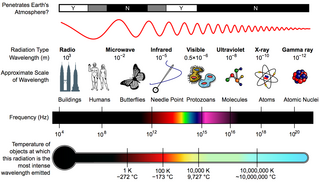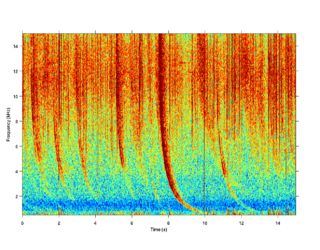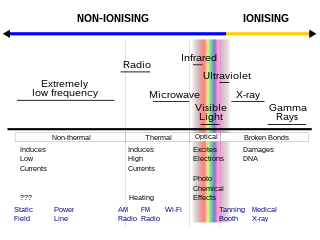Wavelength
The speed of sound at room temperature (20°C) is 343.15 m/s. [4] Using the formula
we have:
Typical female voices range from 1.3 metres (4 ft ) to 2 metres (7 ft).
Typical male voices range from 2.2 metres (7 ft) to 4 metres (13 ft).
| Name | Range (Hz) |
|---|---|
| Narrowband | 300–3,400 |
| Wideband | 50–7,000 |
| Superwideband | 50–14,000 |
| Fullband | 20–20,000 |
A voice frequency (VF) or voice band is the range of audio frequencies used for the transmission of speech.
In telephony, the usable voice frequency band ranges from approximately 300 to 3400 Hz. [2] It is for this reason that the ultra low frequency band of the electromagnetic spectrum between 300 and 3000 Hz is also referred to as voice frequency, being the electromagnetic energy that represents acoustic energy at baseband. The bandwidth allocated for a single voice-frequency transmission channel is usually 4 kHz, including guard bands, [2] allowing a sampling rate of 8 kHz to be used as the basis of the pulse-code modulation system used for the digital PSTN. Per the Nyquist–Shannon sampling theorem, the sampling frequency (8 kHz) must be at least twice the highest component of the voice frequency via appropriate filtering prior to sampling at discrete times (4 kHz) for effective reconstruction of the voice signal.
The voiced speech of a typical adult male will have a fundamental frequency from 90 to 155 Hz, and that of a typical adult female from 165 to 255 Hz. [3] Thus, the fundamental frequency of most speech falls below the bottom of the voice frequency band as defined. However, enough of the harmonic series will be present for the missing fundamental to create the impression of hearing the fundamental tone.
The speed of sound at room temperature (20°C) is 343.15 m/s. [4] Using the formula
we have:
Typical female voices range from 1.3 metres (4 ft ) to 2 metres (7 ft).
Typical male voices range from 2.2 metres (7 ft) to 4 metres (13 ft).

The electromagnetic spectrum is the full range of electromagnetic radiation, organized by frequency or wavelength. The spectrum is divided into separate bands, with different names for the electromagnetic waves within each band. From low to high frequency these are: radio waves, microwaves, infrared, visible light, ultraviolet, X-rays, and gamma rays. The electromagnetic waves in each of these bands have different characteristics, such as how they are produced, how they interact with matter, and their practical applications.

Frequency, most often measured in hertz, is the number of occurrences of a repeating event per unit of time. It is also occasionally referred to as temporal frequency for clarity and to distinguish it from spatial frequency. Ordinary frequency is related to angular frequency by a factor of 2π. The period is the interval of time between events, so the period is the reciprocal of the frequency: f = 1/T.

In physics, radiation is the emission or transmission of energy in the form of waves or particles through space or a material medium. This includes:

In physics and mathematics, wavelength or spatial period of a wave or periodic function is the distance over which the wave's shape repeats. In other words, it is the distance between consecutive corresponding points of the same phase on the wave, such as two adjacent crests, troughs, or zero crossings. Wavelength is a characteristic of both traveling waves and standing waves, as well as other spatial wave patterns. The inverse of the wavelength is called the spatial frequency. Wavelength is commonly designated by the Greek letter lambda (λ). The term "wavelength" is also sometimes applied to modulated waves, and to the sinusoidal envelopes of modulated waves or waves formed by interference of several sinusoids.

Very low frequency or VLF is the ITU designation for radio frequencies (RF) in the range of 3–30 kHz, corresponding to wavelengths from 100 to 10 km, respectively. The band is also known as the myriameter band or myriameter wave as the wavelengths range from one to ten myriameters. Due to its limited bandwidth, audio (voice) transmission is highly impractical in this band, and therefore only low data rate coded signals are used. The VLF band is used for a few radio navigation services, government time radio stations and for secure military communication. Since VLF waves can penetrate at least 40 meters (131 ft) into saltwater, they are used for military communication with submarines.
Low frequency (LF) is the ITU designation for radio frequencies (RF) in the range of 30–300 kHz. Since its wavelengths range from 10–1 km, respectively, it is also known as the kilometre band or kilometre waves.

Medium frequency (MF) is the ITU designation for radio frequencies (RF) in the range of 300 kilohertz (kHz) to 3 megahertz (MHz). Part of this band is the medium wave (MW) AM broadcast band. The MF band is also known as the hectometer band as the wavelengths range from ten to one hectometers. Frequencies immediately below MF are denoted as low frequency (LF), while the first band of higher frequencies is known as high frequency (HF). MF is mostly used for AM radio broadcasting, navigational radio beacons, maritime ship-to-shore communication, and transoceanic air traffic control.

In radio, longwave, long wave or long-wave, and commonly abbreviated LW, refers to parts of the radio spectrum with wavelengths longer than what was originally called the medium-wave broadcasting band. The term is historic, dating from the early 20th century, when the radio spectrum was considered to consist of longwave (LW), medium-wave (MW), and short-wave (SW) radio bands. Most modern radio systems and devices use wavelengths which would then have been considered 'ultra-short'.
CHU is the call sign of a shortwave time signal radio station operated by the Institute for National Measurement Standards of the National Research Council. CHU's signal is used for continuous dissemination of official Canadian government time signals, derived from atomic clocks.
An audio frequency or audible frequency (AF) is a periodic vibration whose frequency is audible to the average human. The SI unit of frequency is the hertz (Hz). It is the property of sound that most determines pitch.
The radio spectrum is the part of the electromagnetic spectrum with frequencies from 3 Hz to 3,000 GHz (3 THz). Electromagnetic waves in this frequency range, called radio waves, are widely used in modern technology, particularly in telecommunication. To prevent interference between different users, the generation and transmission of radio waves is strictly regulated by national laws, coordinated by an international body, the International Telecommunication Union (ITU).
The pulse-repetition frequency (PRF) is the number of pulses of a repeating signal in a specific time unit. The term is used within a number of technical disciplines, notably radar.
From early in the 20th century, the radio frequency of 500 kilohertz (500 kHz) was an international calling and distress frequency for Morse code maritime communication. For much of its early history, this frequency was referred to by its equivalent wavelength, 600 meters, or, using the earlier frequency unit name, 500 kilocycles or 500 kc.

An Alexanderson alternator is a rotating machine invented by Ernst Alexanderson in 1904 for the generation of high-frequency alternating current for use as a radio transmitter. It was one of the first devices capable of generating the continuous radio waves needed for transmission of amplitude modulated signals by radio. It was used from about 1910 in a few "superpower" longwave radiotelegraphy stations to transmit transoceanic message traffic by Morse code to similar stations all over the world.
Airband or aircraft band is the name for a group of frequencies in the VHF radio spectrum allocated to radio communication in civil aviation, sometimes also referred to as VHF, or phonetically as "Victor". Different sections of the band are used for radionavigational aids and air traffic control.
Amateur radio frequency allocation is done by national telecommunication authorities. Globally, the International Telecommunication Union (ITU) oversees how much radio spectrum is set aside for amateur radio transmissions. Individual amateur stations are free to use any frequency within authorized frequency ranges; authorized bands may vary by the class of the station license.

A radio atmospheric signal or sferic is a broadband electromagnetic impulse that occurs as a result of natural atmospheric lightning discharges. Sferics may propagate from their lightning source without major attenuation in the Earth–ionosphere waveguide, and can be received thousands of kilometres from their source. On a time-domain plot, a sferic may appear as a single high-amplitude spike in the time-domain data. On a spectrogram, a sferic appears as a vertical stripe that may extend from a few kHz to several tens of kHz, depending on atmospheric conditions.

In physics, sound is a vibration that propagates as an acoustic wave through a transmission medium such as a gas, liquid or solid. In human physiology and psychology, sound is the reception of such waves and their perception by the brain. Only acoustic waves that have frequencies lying between about 20 Hz and 20 kHz, the audio frequency range, elicit an auditory percept in humans. In air at atmospheric pressure, these represent sound waves with wavelengths of 17 meters (56 ft) to 1.7 centimeters (0.67 in). Sound waves above 20 kHz are known as ultrasound and are not audible to humans. Sound waves below 20 Hz are known as infrasound. Different animal species have varying hearing ranges.
Photon energy is the energy carried by a single photon. The amount of energy is directly proportional to the photon's electromagnetic frequency and thus, equivalently, is inversely proportional to the wavelength. The higher the photon's frequency, the higher its energy. Equivalently, the longer the photon's wavelength, the lower its energy.

Non-ionizingradiation refers to any type of electromagnetic radiation that does not carry enough energy per quantum to ionize atoms or molecules—that is, to completely remove an electron from an atom or molecule. Instead of producing charged ions when passing through matter, non-ionizing electromagnetic radiation has sufficient energy only for excitation. Non-ionizing radiation is not a significant health risk. In contrast, ionizing radiation has a higher frequency and shorter wavelength than non-ionizing radiation, and can be a serious health hazard: exposure to it can cause burns, radiation sickness, many kinds of cancer, and genetic damage. Using ionizing radiation requires elaborate radiological protection measures, which in general are not required with non-ionizing radiation.
![]() This article incorporates public domain material from Federal Standard 1037C. General Services Administration. Archived from the original on 2022-01-22. (in support of MIL-STD-188).
This article incorporates public domain material from Federal Standard 1037C. General Services Administration. Archived from the original on 2022-01-22. (in support of MIL-STD-188).